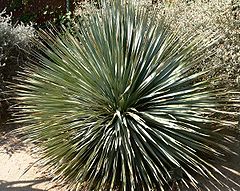Dasylirion
| {{{name}}} Dasylirion
|
'
| ||||||||||||||||||||||||||||||||||||||||
|---|---|---|---|---|---|---|---|---|---|---|---|---|---|---|---|---|---|---|---|---|---|---|---|---|---|---|---|---|---|---|---|---|---|---|---|---|---|---|---|---|---|

|
|
| |||||||||||||||||||||||||||||||||||||||
| |||||||||||||||||||||||||||||||||||||||||
| Standard Cyclopedia of Horticulture |
|---|
|
Dasylirion (Greek, tufted lily). Liliaceae. Stiff short-trunked desert plants, with crowded leaves and elevated panicles of small mostly white or whitish flowers. Caudex or trunk erect and woody: Lvs. numerous, near the top of the trunk, long and rigid, usually prickly-margined: fls. dioecious, in dense racemes which are crowded into a narrow compound panicle; perianth campanulate, the segms. toothed, distinct and nearly equal, obtuse; stamens 6, exserted, style short; stigmas 3: fr. dry and indehiscent, 3-winged, 1-celled and 1-seeded.—About 15 species. Mex., to Texas and Ariz. Dasylirions are highly ornamental plants, well adapted for rockeries, for isolated specimens on lawns, decoration of conservatories, staircases and similar uses, and eminently suitable for terraces and vases, in the formal style of gardening. The leaves are in large number, inserted in a symmetrical way, so as to form a dome or globe-shaped, regular head, more or less serrulated, and in some species ending in a brush- like tuft of dried fibers. The tall panicles of numberless whitish green minute flowers are also a striking feature, standing far above the crest or crown of leaves. They are of the easiest possible culture, and will stand some degrees of frost, particularly if kept dry. Easily propagated from seeds and from cuttings of the branches when produced, as they do not sucker as a rule. These plants are inferior to Yucca filamentosa in hardiness, showiness and regularity of flowering, but they have an individuality of their own. They are especially esteemed in California, where the great flower-stalks, 8 to 10 feet high, give a strong impression of the desert. The individual flowers are not highly colored, but the spikes are several feet long. These and related plants have been the subject of recent revision. Beaucarnea is now considered to be distinct, and a new genus, Calibanus, is erected by Rose on D. caespitosum. These new treatments are explained under Nolina. CH
|
Cultivation
- Do you have cultivation info on this plant? Edit this section!
Propagation
- Do you have propagation info on this plant? Edit this section!
Pests and diseases
- Do you have pest and disease info on this plant? Edit this section!
Species
- Selected species
- Dasylirion acrotrichum
- Dasylirion leiophyllum (syn. D. heteracanthum)
- Dasylirion longissimum
- Dasylirion lucidum
- Dasylirion texanum
- Dasylirion wheeleri
D. Hookeri, Lem. (syn. Calibanus Hookeri, Trei. (see Nolina)). —D. junceum, Zucc.=Nolina Hartwegiana.—D. longifolium, Zucc.-Nolina longifolia.CH
Gallery
If you have a photo of this plant, please upload it! Plus, there may be other photos available for you to add.
References
- Standard Cyclopedia of Horticulture, by L. H. Bailey, MacMillan Co., 1963
External links
- w:Dasylirion. Some of the material on this page may be from Wikipedia, under the Creative Commons license.
- Dasylirion QR Code (Size 50, 100, 200, 500)
